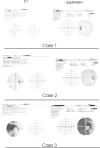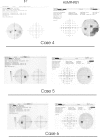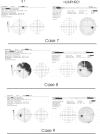Visual field examination using a video projector: comparison with Humphrey perimeter
- PMID: 24648716
- PMCID: PMC3956739
- DOI: 10.2147/OPTH.S54524
Visual field examination using a video projector: comparison with Humphrey perimeter
Abstract
Purpose: To present a method of visual field examination using a video projector. Also, we compare our results with those of a Humphrey perimeter, which is accepted as standard in automated perimetry.
Materials and methods: Software implementing a full-threshold 4-2-step staircase algorithm for the central 30-2 of the visual field (76 points) has been developed and tested in nine eyes of seven patients using an Epson TW 700 video projector. The results were compared to those obtained from the same patients using the Humphrey perimeter.
Results: High correlation between the video projector visual fields and those of the Humphrey perimeter was found. The point-to-point correlation coefficient ranged from 0.75 to 0.90, with P<0.0001 for each eye.
Conclusion: Visual field examination results using a video projector have high correlation with those of a Humphrey perimeter. The method is possibly suitable for clinical use.
Keywords: automated perimetry; computerized perimetry; video projector; visual field software; visual fields.
Figures






References
-
- Wu JX, Wormald R, Fitzke F, Poinoosawmy D, Nagasubramanian S, Hitchings R. Laptop computer perimetry for glaucoma screening. Invest Opthalmol Vis Sci. 1991;32:810.
-
- Quigley HA, West SK, Munoz B, Mmbaga BBO, Glovinsky Y. Examination methods for glaucoma surveys. Arch Ophthalmol. 1993;111:1409–1415. - PubMed
-
- Wall M, Brito C, Kutzko K. Motion detection perimetry: properties and results. In: Wall M, Heijl A, editors. Perimetry Update 1996/1997. Amsterdam: Kugler; 1997. pp. 21–33.
-
- Kasha JR, Jr, inventor, Patent Storm, assignee Visual field perimetry on a small computer screen. Oct 15, 1996. United States patent US 5565949.
LinkOut - more resources
Full Text Sources
Other Literature Sources

